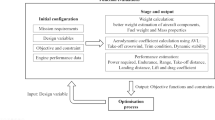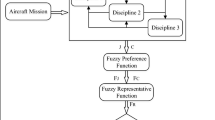Abstract
Concept design requiring complicated feed-forward and feed-back processes makes it difficult for engineers to determine the global behaviors of design variables and objective functions in a design space. Although design of experiments and response surface models have been applied to overcome these problems, the design variables satisfying the objective functions can’t be found due to violations of given constraints. In this study, a new optimization process, i.e., the GEO (Generate, Explore and Optimize) process for the concept design of a tactical missile, based on a MOGA (Multi-Objective Genetic Algorithm) was proposed, which was first adapted to generate a Pareto Front in order to simultaneously satisfy the constraints and the objective functions. In the first step, the weights between the objective functions were determined by using an AHP (Analytic Hierarchy Process). Then, the design space exploration followed, and was implemented by surrogate models constructed from the Pareto Front with a neural network. In the last step, a TOPSIS (Technique for Order Preference by Similarity to Ideal Solution) and a desirability function were applied together to determine the optimal solution. The TOPSIS merged the multi-objective design problem to a single entity, and the desirability function normalized each objective function.
Similar content being viewed by others
References
Myers, R. H. and Montgomery, D. C., “Response Surface Methodology: Process and Product in Optimization Using Designed Experiments,” John Wiley & Sons, pp. 208–341, 1995.
Del Castillo, E., “Process Optimization: a Statistical Approach,” Springer, pp. 85–147, 2007.
Deb, K., “Multi-Objective Optimisation Using Evolutionary Algorithms: An Introduction,” in Multi-objective Evolutionary Optimisation for Product Design and Manufacturing, pp. 3–34, 2011.
Konak, A., Coit, D. W., and Smith, A. E., “Multi-Objective Optimization using Genetic Algorithms: A Tutorial,” Reliability Engineering & System Safety, Vol. 91, No. 9, pp. 992–1007, 2006.
Saaty, T. L., “A Scaling Method for Priorities in Hierarchical Structures,” Journal of Mathematical Psychology, Vol. 15, No. 3, pp. 234–281, 1977.
Lee, K. K. and Han, S. H., “Optimization of Wind Turbine Pitch Controller by Neural Network Model Based on Latin Hypercube,” Transactions of the Korean Society of Mechanical Engineers A, Vol. 36, No. 9, pp. 1065–1071, 2012.
Lee, K. K., Lee, K. H., and Han, S. H., “Use of an Orthogonal Array based on the Kriging Model to Maximize the Fatigue Life of a Turbine Blade,” International Journal of Structural Integrity, Vol. 2, No. 3, pp. 303–312, 2011.
Eugene, L. F., “Tactical Missile Design,” AIAA Education Series, AIAA, pp. 1–18, 2001.
Lee, K. K., Han, J. W., and Han, S. H., “TOPSIS-Based Multi-Objective Shape Optimization for a CRT Funnel,” Transactions of the Korean Society of Mechanical Engineers A, Vol. 35, No. 7, pp. 729–736, 2011.
Frits, A. P., Fleeman, E. L., and Mavris, D. N., “Use of a Conceptual Sizing Tool for Conceptual Design of Tactical Missiles (U),” Proc. of the Missile Sciences Conference, 2002.
Ramu, M., Raja, V. P., Thyla, P., and Gunaseelan, M., “Design Optimization of Complex Structures Using Metamodels,” Jordan Journal of Mechanical & Industrial Engineering, Vol. 4, No. 5, pp. 653–663, 2010.
Hamza, R. M. A., “Multi-Objective Neural Network Modeling for Improving Stud Arc Welding Process Joining,” Journal of Engineering Science and Technology, Vol. 6, No. 3, pp. 382–391, 2011.
SAS Institute Inc., “JMP 10 User’s Guide,” 2011.
Munier, N., “A Strategy for Using Multicriteria Analysis in Decision-Making,” Springer, pp. 77–100, 2011.
Derringer, G., “Simultaneous Optimization of Several Response Variables,” Journal of Quality Technology, Vol. 12, No. 4, pp. 214–219, 1980.
Author information
Authors and Affiliations
Corresponding author
Rights and permissions
About this article
Cite this article
Lee, KK., Lee, KH., Woo, ET. et al. Optimization process for concept design of tactical missiles by using pareto front and TOPSIS. Int. J. Precis. Eng. Manuf. 15, 1371–1376 (2014). https://doi.org/10.1007/s12541-014-0478-7
Received:
Revised:
Accepted:
Published:
Issue Date:
DOI: https://doi.org/10.1007/s12541-014-0478-7




